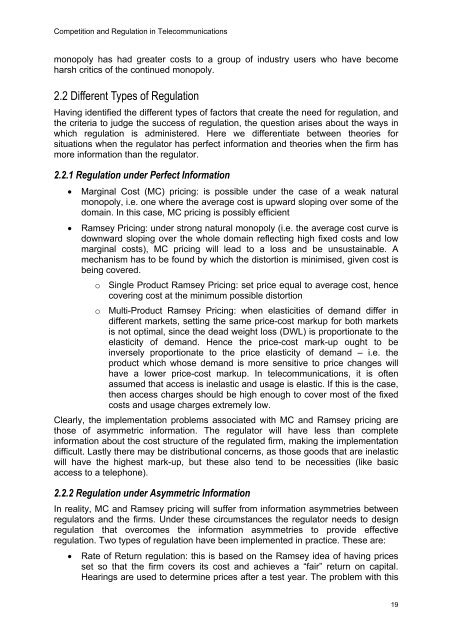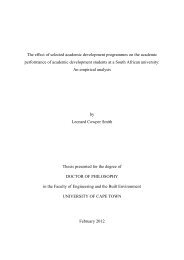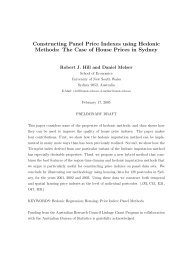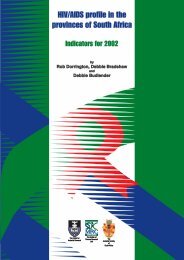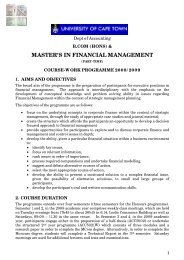Competition and Regulation in the Telecommunications Industry in ...
Competition and Regulation in the Telecommunications Industry in ...
Competition and Regulation in the Telecommunications Industry in ...
Create successful ePaper yourself
Turn your PDF publications into a flip-book with our unique Google optimized e-Paper software.
<strong>Competition</strong> <strong>and</strong> <strong>Regulation</strong> <strong>in</strong> <strong>Telecommunications</strong>monopoly has had greater costs to a group of <strong>in</strong>dustry users who have becomeharsh critics of <strong>the</strong> cont<strong>in</strong>ued monopoly.2.2 Different Types of <strong>Regulation</strong>Hav<strong>in</strong>g identified <strong>the</strong> different types of factors that create <strong>the</strong> need for regulation, <strong>and</strong><strong>the</strong> criteria to judge <strong>the</strong> success of regulation, <strong>the</strong> question arises about <strong>the</strong> ways <strong>in</strong>which regulation is adm<strong>in</strong>istered. Here we differentiate between <strong>the</strong>ories forsituations when <strong>the</strong> regulator has perfect <strong>in</strong>formation <strong>and</strong> <strong>the</strong>ories when <strong>the</strong> firm hasmore <strong>in</strong>formation than <strong>the</strong> regulator.2.2.1 <strong>Regulation</strong> under Perfect Information• Marg<strong>in</strong>al Cost (MC) pric<strong>in</strong>g: is possible under <strong>the</strong> case of a weak naturalmonopoly, i.e. one where <strong>the</strong> average cost is upward slop<strong>in</strong>g over some of <strong>the</strong>doma<strong>in</strong>. In this case, MC pric<strong>in</strong>g is possibly efficient• Ramsey Pric<strong>in</strong>g: under strong natural monopoly (i.e. <strong>the</strong> average cost curve isdownward slop<strong>in</strong>g over <strong>the</strong> whole doma<strong>in</strong> reflect<strong>in</strong>g high fixed costs <strong>and</strong> lowmarg<strong>in</strong>al costs), MC pric<strong>in</strong>g will lead to a loss <strong>and</strong> be unsusta<strong>in</strong>able. Amechanism has to be found by which <strong>the</strong> distortion is m<strong>in</strong>imised, given cost isbe<strong>in</strong>g covered.o S<strong>in</strong>gle Product Ramsey Pric<strong>in</strong>g: set price equal to average cost, hencecover<strong>in</strong>g cost at <strong>the</strong> m<strong>in</strong>imum possible distortiono Multi-Product Ramsey Pric<strong>in</strong>g: when elasticities of dem<strong>and</strong> differ <strong>in</strong>different markets, sett<strong>in</strong>g <strong>the</strong> same price-cost markup for both marketsis not optimal, s<strong>in</strong>ce <strong>the</strong> dead weight loss (DWL) is proportionate to <strong>the</strong>elasticity of dem<strong>and</strong>. Hence <strong>the</strong> price-cost mark-up ought to be<strong>in</strong>versely proportionate to <strong>the</strong> price elasticity of dem<strong>and</strong> – i.e. <strong>the</strong>product which whose dem<strong>and</strong> is more sensitive to price changes willhave a lower price-cost markup. In telecommunications, it is oftenassumed that access is <strong>in</strong>elastic <strong>and</strong> usage is elastic. If this is <strong>the</strong> case,<strong>the</strong>n access charges should be high enough to cover most of <strong>the</strong> fixedcosts <strong>and</strong> usage charges extremely low.Clearly, <strong>the</strong> implementation problems associated with MC <strong>and</strong> Ramsey pric<strong>in</strong>g arethose of asymmetric <strong>in</strong>formation. The regulator will have less than complete<strong>in</strong>formation about <strong>the</strong> cost structure of <strong>the</strong> regulated firm, mak<strong>in</strong>g <strong>the</strong> implementationdifficult. Lastly <strong>the</strong>re may be distributional concerns, as those goods that are <strong>in</strong>elasticwill have <strong>the</strong> highest mark-up, but <strong>the</strong>se also tend to be necessities (like basicaccess to a telephone).2.2.2 <strong>Regulation</strong> under Asymmetric InformationIn reality, MC <strong>and</strong> Ramsey pric<strong>in</strong>g will suffer from <strong>in</strong>formation asymmetries betweenregulators <strong>and</strong> <strong>the</strong> firms. Under <strong>the</strong>se circumstances <strong>the</strong> regulator needs to designregulation that overcomes <strong>the</strong> <strong>in</strong>formation asymmetries to provide effectiveregulation. Two types of regulation have been implemented <strong>in</strong> practice. These are:• Rate of Return regulation: this is based on <strong>the</strong> Ramsey idea of hav<strong>in</strong>g pricesset so that <strong>the</strong> firm covers its cost <strong>and</strong> achieves a “fair” return on capital.Hear<strong>in</strong>gs are used to determ<strong>in</strong>e prices after a test year. The problem with this19


